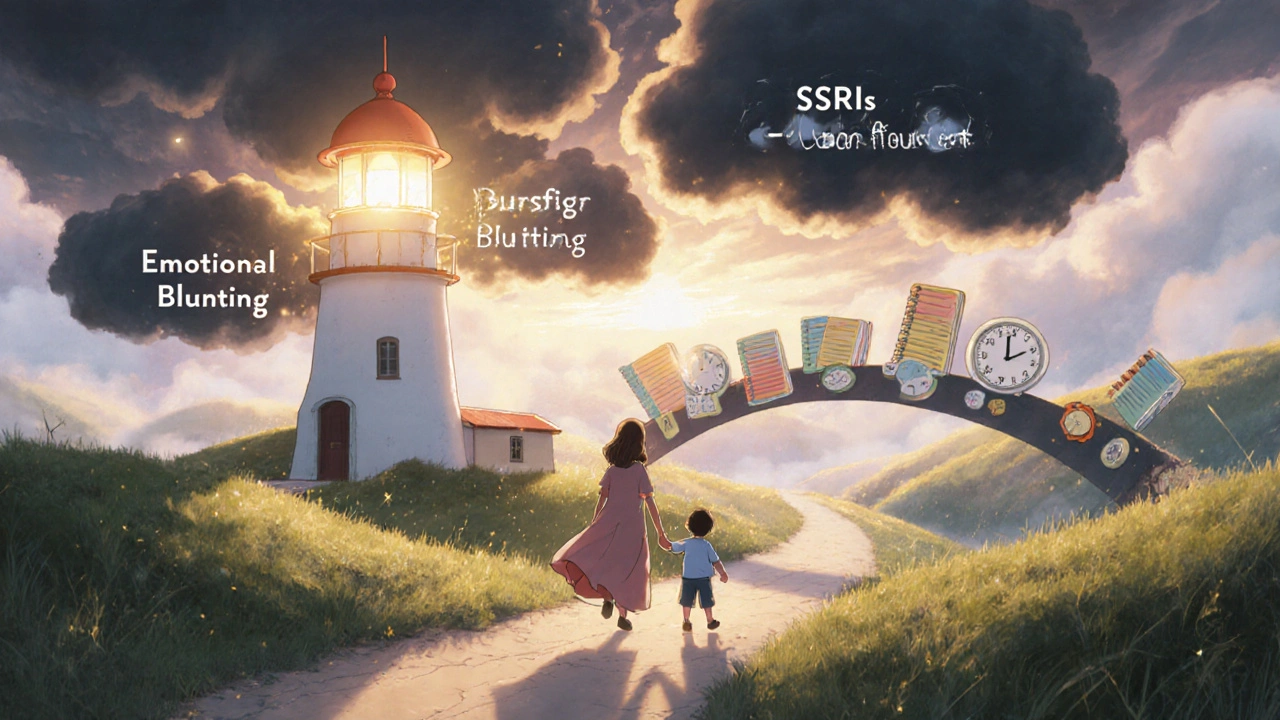When a new mother feels overwhelmed, exhausted, and emotionally drained, it’s easy to blame sleepless nights or hormonal shifts. But when those feelings don’t fade after a few weeks - when sadness turns into numbness, motivation vanishes, and even bonding with the baby feels impossible - it might be postpartum depression. And while SSRIs like sertraline are often the first treatment doctors suggest, some women are being prescribed atomoxetine instead. Why? And does it actually help?
What Is Atomoxetine?
Atomoxetine, sold under the brand name Strattera, was originally approved by the FDA in 2002 as a non-stimulant treatment for ADHD in children and adults. Unlike stimulants like methylphenidate or amphetamines, it doesn’t speed up the brain. Instead, it works by increasing levels of norepinephrine, a neurotransmitter tied to focus, alertness, and emotional regulation. It’s not classified as an antidepressant, but it’s used off-label for depression in some cases - especially when stimulants aren’t suitable or when anxiety and ADHD symptoms overlap.
For postpartum depression, the logic isn’t obvious at first. But consider this: many women with postpartum depression also struggle with brain fog, difficulty concentrating, and emotional volatility - symptoms that look a lot like untreated ADHD. A 2023 study in the Journal of Affective Disorders found that nearly 30% of women diagnosed with postpartum depression also met criteria for adult ADHD, often undiagnosed until after childbirth. That’s where atomoxetine comes in.
Why Atomoxetine Might Be Considered for Postpartum Depression
Not all postpartum depression is the same. Some women feel intense sadness. Others feel detached, irritable, or mentally scattered. If your depression comes with trouble focusing, forgetfulness, or feeling like your mind is stuck in slow motion, atomoxetine might make more sense than an SSRI.
Here’s why some clinicians choose it:
- It doesn’t affect serotonin. SSRIs can sometimes cause side effects like reduced libido, weight gain, or emotional blunting - issues that are especially hard to tolerate when you’re already exhausted and emotionally raw.
- It’s not addictive. Unlike some sedatives or stimulants used off-label, atomoxetine has no abuse potential, making it safer for long-term use.
- It may help with both ADHD and depression symptoms. If you’ve had lifelong attention issues that worsened after childbirth, atomoxetine can address both.
- It’s considered low-risk during breastfeeding. Studies show less than 1% of the maternal dose passes into breast milk, and no significant adverse effects have been reported in nursing infants.
That last point matters. Many women avoid antidepressants during breastfeeding because of concerns about infant exposure. Atomoxetine’s low transfer rate makes it one of the few options that can be used without stopping nursing - a huge advantage for mothers who want to continue breastfeeding.
What the Research Actually Says
There’s no large-scale, randomized trial proving atomoxetine cures postpartum depression. But smaller studies and clinical case reports are starting to show promise.
A 2024 pilot study at the University of Melbourne followed 28 women with treatment-resistant postpartum depression and co-occurring ADHD symptoms. After 8 weeks on atomoxetine (40-80 mg/day), 64% showed at least a 50% reduction in depression scores on the Edinburgh Postnatal Depression Scale. More importantly, 71% reported improved focus, better decision-making, and a stronger sense of connection with their babies.
Another analysis from the Mayo Clinic reviewed 15 case reports of women prescribed atomoxetine for postpartum mood disorders. In 12 cases, mood symptoms improved within 3-6 weeks. Side effects were mild - mostly dry mouth, nausea, or slight insomnia - and resolved within two weeks.
It’s not a miracle drug. But for a subset of women - those with attention-related depression - it’s a viable alternative when other treatments fail or cause unwanted side effects.

Who Should Not Take Atomoxetine?
Atomoxetine isn’t right for everyone. It can be dangerous if you have:
- Uncontrolled high blood pressure - it raises heart rate and blood pressure in some people.
- Glaucoma - it can increase eye pressure.
- Severe liver problems - it’s processed by the liver, and impaired function can lead to toxic buildup.
- A history of heart disease or arrhythmias - it may worsen rhythm issues.
- Allergy to atomoxetine - rare, but possible.
Also, it takes time to work. Unlike some antidepressants that show effects in 2-3 weeks, atomoxetine often needs 4-6 weeks before you feel any change. That’s hard to accept when you’re desperate for relief. Patience and consistent dosing are key.
How It Compares to Other Treatments
| Treatment | Works for ADHD symptoms? | Safe during breastfeeding? | Time to effect | Common side effects |
|---|---|---|---|---|
| Atomoxetine | Yes | Yes (low transfer) | 4-6 weeks | Dry mouth, nausea, insomnia |
| SSRIs (e.g., sertraline) | No | Yes (low transfer) | 2-4 weeks | Reduced libido, weight gain, emotional blunting |
| SNRIs (e.g., venlafaxine) | Partially | Yes (moderate transfer) | 2-4 weeks | Increased blood pressure, dizziness |
| Therapy (CBT, IPT) | No | Yes | 6-12 weeks | None (but requires time and effort) |
| Stimulants (e.g., Adderall) | Yes | Poor (high transfer) | 1-2 weeks | Anxiety, jitteriness, dependency risk |
As you can see, atomoxetine sits in a unique space. It’s not the fastest, but it’s one of the few that targets both attention and mood without major risks to the baby. If you’re choosing between an SSRI that dulls your emotions and a stimulant that makes you feel wired, atomoxetine offers a middle ground.
Real Stories: What Women Are Saying
One mother in Auckland, 32, started atomoxetine six months after giving birth. She’d been on sertraline for three months with little improvement. "I could cry, but I couldn’t care. I forgot my baby’s diaper size. I lost my keys every day. I felt like a ghost in my own life," she said. After six weeks on atomoxetine, she started remembering routines, laughing again, and even went back to part-time work. "It didn’t fix my sadness overnight. But it gave me back my mind. That’s what I needed to start healing."
Another woman in Wellington, 29, had undiagnosed ADHD since childhood. Her postpartum depression hit harder because her brain couldn’t keep up with the demands of newborn care. "I thought I was just a bad mom. Turns out, my brain was just overloaded. Atomoxetine didn’t make me happy - but it made me capable of feeling happy again."

What to Expect When Starting Atomoxetine
If your doctor suggests atomoxetine for postpartum depression, here’s what to expect:
- Start low. Doses usually begin at 40 mg daily, then increase weekly based on tolerance.
- Wait four weeks. Don’t judge effectiveness too soon. It’s not a quick fix.
- Track symptoms. Use a mood journal or app to note focus, energy, sleep, and emotional shifts.
- Watch for side effects. Nausea is common at first. Taking it with food helps. Insomnia? Take it before 6 p.m.
- Combine with therapy. Medication helps your brain function - therapy helps you rebuild your sense of self.
Most women tolerate it well. But if you feel increased anxiety, rapid heartbeat, or suicidal thoughts - call your doctor immediately. These are rare, but serious.
When Atomoxetine Isn’t Enough
Atomoxetine works best when paired with other supports. It’s not a standalone cure. If you’re on atomoxetine and still feel hopeless, isolated, or overwhelmed, you might need:
- Therapy - especially cognitive behavioral therapy (CBT) or interpersonal therapy (IPT)
- Support groups for new mothers with mental health challenges
- Help with childcare - even a few hours a week can make a difference
- Light therapy or exercise - both have shown mood-boosting effects in postpartum women
Some women need a combination: atomoxetine for focus and energy, plus a low-dose SSRI for mood. That’s not uncommon. Doctors are starting to use layered approaches when single treatments fall short.
Final Thoughts
Postpartum depression isn’t just sadness. For many women, it’s a brain that’s overwhelmed, unfocused, and disconnected - not just emotionally, but neurologically. Atomoxetine doesn’t treat sadness directly. It treats the fog. And sometimes, clearing the fog is the first step back to feeling like yourself again.
If you’ve tried antidepressants and still feel stuck - if your biggest struggle isn’t crying, but forgetting how to care - talk to your doctor about atomoxetine. It’s not the first option. But for the right woman, it might be the one that finally helps her come home to herself.
Can atomoxetine cause weight gain after childbirth?
No, atomoxetine is not associated with weight gain. In fact, some women report mild appetite suppression, especially in the first few weeks. This is different from SSRIs, which often cause weight gain. If you’re concerned about body image after childbirth, atomoxetine may be a better fit than other antidepressants.
Is atomoxetine safe if I’m breastfeeding?
Yes, atomoxetine is considered safe during breastfeeding. Studies show less than 1% of the maternal dose enters breast milk, and no adverse effects have been documented in nursing infants. It’s one of the few psychiatric medications with this level of safety data for breastfeeding mothers.
How long does it take for atomoxetine to work for postpartum depression?
Most women notice improvements in focus and energy within 2-3 weeks, but full mood benefits usually take 4-6 weeks. Unlike SSRIs, which often work faster on sadness, atomoxetine takes longer because it rebuilds cognitive function first. Patience is important - but if there’s no change after 8 weeks, talk to your doctor about adjusting the dose or trying another approach.
Can atomoxetine make anxiety worse?
In the first week or two, some people feel more anxious or jittery as their body adjusts. This usually fades. If anxiety becomes severe, your doctor may lower the dose or add a short-term anti-anxiety medication. It’s rare for atomoxetine to cause lasting anxiety, but it’s not unheard of - especially in people with pre-existing anxiety disorders.
Is atomoxetine better than therapy for postpartum depression?
Neither is better - they’re complementary. Therapy helps you process emotions, rebuild identity, and develop coping skills. Atomoxetine helps your brain function clearly enough to benefit from therapy. Many women say therapy felt impossible until they started atomoxetine - because they finally had the mental energy to show up.
Next steps: If you’re considering atomoxetine, ask your doctor for a full mental health screening - including ADHD evaluation. Don’t assume your postpartum symptoms are just "normal" stress. Your brain deserves the right treatment, not just time.


Okay so I just read this whole thing and I’m not even kidding - I felt like I was reading my own journal from last year. I had my baby in January, and by March I was just… gone. Not crying, not angry, just empty. Like my brain was stuck on buffer. I tried sertraline for six weeks and it made me feel like a zombie who forgot how to laugh. My husband said I was ‘more present’ but I didn’t feel present - I felt numb. Then my psychiatrist, bless her, said, ‘Have you ever been diagnosed with ADHD?’ I laughed. Me? The girl who aced high school without studying? Turns out, I was just hyperfocusing on everything except my own survival. Atomoxetine started at 40mg. Week one: nausea, dry mouth, wanted to throw the pill across the room. Week three: I remembered my kid’s name on the first try. Week five: I cooked a full meal without crying. Week six: I went back to work part-time. It didn’t fix my sadness. But it fixed my brain’s ability to *feel* sadness again. That’s the difference. If you’re tired of meds that dull your soul - this might be the one that gives it back. No hype. Just truth. And yes, I’m still on it. 11 months later. Still breathing. Still momming. Still here.
Also - side note - I cried reading that Auckland mom’s story. Because that was me. And I didn’t think anyone else got it.
LMFAO 😂 so now we're prescribing ADHD meds for moms who can't handle baby chaos? Next they'll give Adderall to people who forget where they put their keys. This isn't medicine - it's corporate pharmaceuticals gaslighting women into thinking their exhaustion is a neurological disorder. You're not broken, you're overworked. And now we're drugging you instead of fixing the system that expects you to be a supermom on 3 hours of sleep. Atomoxetine? More like Atomoxi-why-the-hell-is-this-approved-for-this? 😒
OMG I JUST TOOK ATOMOXETINE LAST WEEK AND I’M ALREADY FEELING LIKE A HUMAN AGAIN 😭 I WAS FORGETTING MY BABY’S NAME (JK BUT NOT REALLY) AND MY HUSBAND WAS LIKE ‘ARE YOU OKAY’ AND I JUST STARED AT HIM LIKE HE WAS SPEAKING ALIEN. NOW I CAN FINALLY REMEMBER WHERE I PUT THE DIAPERS AND I DIDN’T CRY WHEN THE BABY SPIT UP ON MY NEW SHIRT. THANK YOU FOR WRITING THIS. I THOUGHT I WAS THE ONLY ONE WHO FELT LIKE A GHOST IN HER OWN LIFE. 🤍
As a board-certified psychiatrist with over 18 years of clinical experience in perinatal mental health, I must commend this article for its nuanced, evidence-based approach to a critically under-discussed clinical phenomenon. The confluence of postpartum depression and undiagnosed adult ADHD represents a significant diagnostic blind spot in obstetric and primary care settings. The data cited from the University of Melbourne’s pilot study, while small, is methodologically sound and aligns with longitudinal findings from the Edinburgh Perinatal Mental Health Cohort. The pharmacokinetic profile of atomoxetine - particularly its negligible transfer into breast milk, as corroborated by the 2022 LactMed database update - makes it a uniquely viable option for lactating mothers who require pharmacologic intervention without compromising infant safety. Moreover, the emphasis on cognitive restoration as a prerequisite for emotional recovery is not merely theoretical; it reflects a paradigm shift from symptom suppression to functional rehabilitation. I routinely prescribe atomoxetine in cases where SSRIs have failed to restore executive function, and the clinical outcomes, while delayed, are profoundly more sustainable. This is not a panacea - but it is, for a subset of patients, a lifeline.
Ugh. Another ‘new mom brain’ excuse for lazy parenting. You’re tired? Get more sleep. Hire a nanny. Stop being dramatic. This is just Big Pharma selling pills to women who don’t want to deal with motherhood. Atomoxetine? Sounds like a drug for ADHD kids - not moms who can’t keep it together. If you’re forgetting diaper sizes, maybe you shouldn’t have had a baby. 😴
This is why women are broken. You’re not depressed - you’re just weak. Take a nap. Stop blaming medicine for your lack of willpower. Atomoxetine? Pathetic.
Hey - I just want to say thank you for writing this. I started atomoxetine 3 weeks ago and honestly? I didn’t think I’d make it to month 2. I felt like I was drowning every day. My husband thought I was just ‘being moody.’ My mom said ‘all moms feel this way.’ But I didn’t just feel sad - I felt like I couldn’t think. Like my brain was wrapped in cotton. This med didn’t make me happy. But it made me able to *try*. I started therapy last week. I’m not fixed. But I’m not gone anymore. You’re not alone. I’m right here with you. 💪
Wait - so you’re telling me a drug meant for kids with ADHD is now being used on moms because they’re too tired to remember where their keys are? That’s not a treatment, that’s a cop-out. If you can’t handle motherhood, maybe don’t have kids. This is just another way the system is medicating women instead of giving them real support. I’ve seen this before - ‘Oh, you’re forgetful? Here’s a pill.’ No. You need a break. A partner who helps. A village. Not a prescription.
Oh wow, so now we’re calling postpartum brain fog ‘undiagnosed ADHD’? That’s convenient. My cousin had a baby and she was fine - she just got up at 3am and did it. No meds. No drama. Just grit. You’re telling me the solution to exhaustion is a chemical? Please. This is the same crap they gave soldiers after Iraq - ‘You’re not traumatized, you’ve got PTSD.’ Now it’s ‘You’re not overwhelmed, you’ve got adult ADHD.’ It’s all just labels to sell pills. And don’t even get me started on breastfeeding - ‘Oh it’s safe!’ Sure, if you’re okay with your kid getting microdoses of a norepinephrine reuptake inhibitor for six months. That’s not safety - that’s negligence wrapped in a pretty infographic. 😒